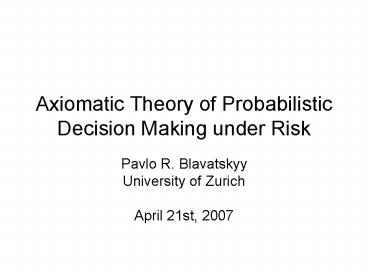Axiomatic Theory of Probabilistic Decision Making under Risk - PowerPoint PPT Presentation
1 / 16
Title:
Axiomatic Theory of Probabilistic Decision Making under Risk
Description:
Axioms. Axiom 1 (Completeness) For any two lotteries there exist a choice probability ... Axioms, continued. Axiom 2 (Strong Stochastic Transitivity) For any ... – PowerPoint PPT presentation
Number of Views:94
Avg rating:3.0/5.0
Title: Axiomatic Theory of Probabilistic Decision Making under Risk
1
Axiomatic Theory of Probabilistic Decision Making
under Risk
- Pavlo R. Blavatskyy
- University of Zurich
- April 21st, 2007
2
Outline
- Introduction
- Framework
- Axioms
- Representation Theorem
- Implications
- Conclusions
3
Introduction
- Experimental studies of repeated decision making
under risk gt individual choices are often
contradictory - Camerer (1989) reports that 31.6 of subjects
reversed their choices - Starmer and Sugden (1989) find that 26.5 of all
choices are reversed - Hey and Orme (1994) report an inconsistency rate
of 25 - Wu (1994) finds that 5 to 45 of choice
decisions are reversed - Ballinger and Wilcox (1997) report a median
switching rate of 20.8
4
Introduction continued
- Majority of decision theories are deterministic
- Exception Machina (1985) and Chew et al. (1991)
- They predict that repeated choice is always
consistent (except for decision problems where an
individual is exactly indifferent) - Common approach is to embed a deterministic
decision theory into a model of stochastic choice - tremble model of Harless and Camerer (1994)
- Fechner model of random errors (e.g. Hey and
Orme, 1994) - Random utility model (e.g. Loomes and Sugden,
1995)
5
This Paper
- Individuals do not have a unique preference
relation on the set of risky lotteries - Individuals possess a probability measure that
captures the likelihood of one lottery being
chosen over another lottery - A related axiomatization of choice probabilities
- Debreu (1958)
- Fishburn (1978)
6
Framework
- A finite set of all possible outcomes
(consequences) - Outcomes are not necessarily monetary payoffs
- A risky lottery is a probability distribution
on X - A compound lottery
- The set of all risky lotteries is denoted by ?
7
Framework, continued
- An individual possesses a probability measure on
- Choice probability
denotes a likelihood that an individual
chooses L1 over L2 in a repeated binary choice - A deterministic preference relation can be easily
converted into a choice probability - If an individual strictly prefers L1 over L2,
then - If an individual strictly prefers L2 over L1,
then - If an individual is exactly indifferent, then
8
Axioms
- Axiom 1 (Completeness) For any two lotteries
there exist a choice probability
and a choice probability - for any
- Only two events are possible either choose L1
or choose L2
9
Axioms, continued
- Axiom 2 (Strong Stochastic Transitivity) For any
three lotteries if and then - Axiom 3 (Continuity) For any three lotteries
the sets - and
- are closed
10
Axioms, continued
- Axiom 4 (Common Consequence Independence) For any
four lotteries and any probability
- If two risky lotteries yield identical chances of
the same outcome (or, more generally, if two
compound lotteries yield identical chances of the
same risky lottery) this common consequence does
not affect the choice probability
11
Axioms, continued
- Axiom 5 (Interchangeability) For any three
lotteries if then - If an individual chooses between two lotteries at
random then he or she does not mind which of the
two lotteries is involved in another decision
problem
12
Representation Theorem
- Theorem 1 (Stochastic Utility Theorem)
Probability measure on satisfies Axioms
1-5 if and only if there exist an assignment of
real numbers to every outcome ,
, and there exist a non-decreasing
function such that for any two
risky lotteries
13
Implications
- Function has to satisfy a restriction
for every , which immediately implies
that - If a vector and function
represent a probability measure on then a
vector and a function
represent the same probability measure for any
two real numbers a and b,
14
Special cases
- Fechner model of random errors
- function is a cumulative distribution
function of the normal distribution with mean
zero and constant standard deviation - Luce choice model
- function is a cumulative distribution
function of the logistic distribution - where is constant
- Tremble model of Harless and Camerer (1994)
- function is the step function
15
Empirical paradoxes
- Unlike expected utility theory, stochastic
utility theory is consistent with systematic
violations of betweenness and a common ratio
effect - but cannot explain a common consequence effect
16
Conclusions
- Individuals often make contradictory choices
- Either individuals have multiple preference
relations on ? (random utility model) - or individuals have a probability measure on
- Choice probabilities admit a stochastic utility
representation if and only if they are complete,
strongly transitive, continuous, independent of
common consequences and interchangeable - Special cases Fechner model of random errors,
Luce choice model and a tremble model of Harless
and Camerer (1994)































